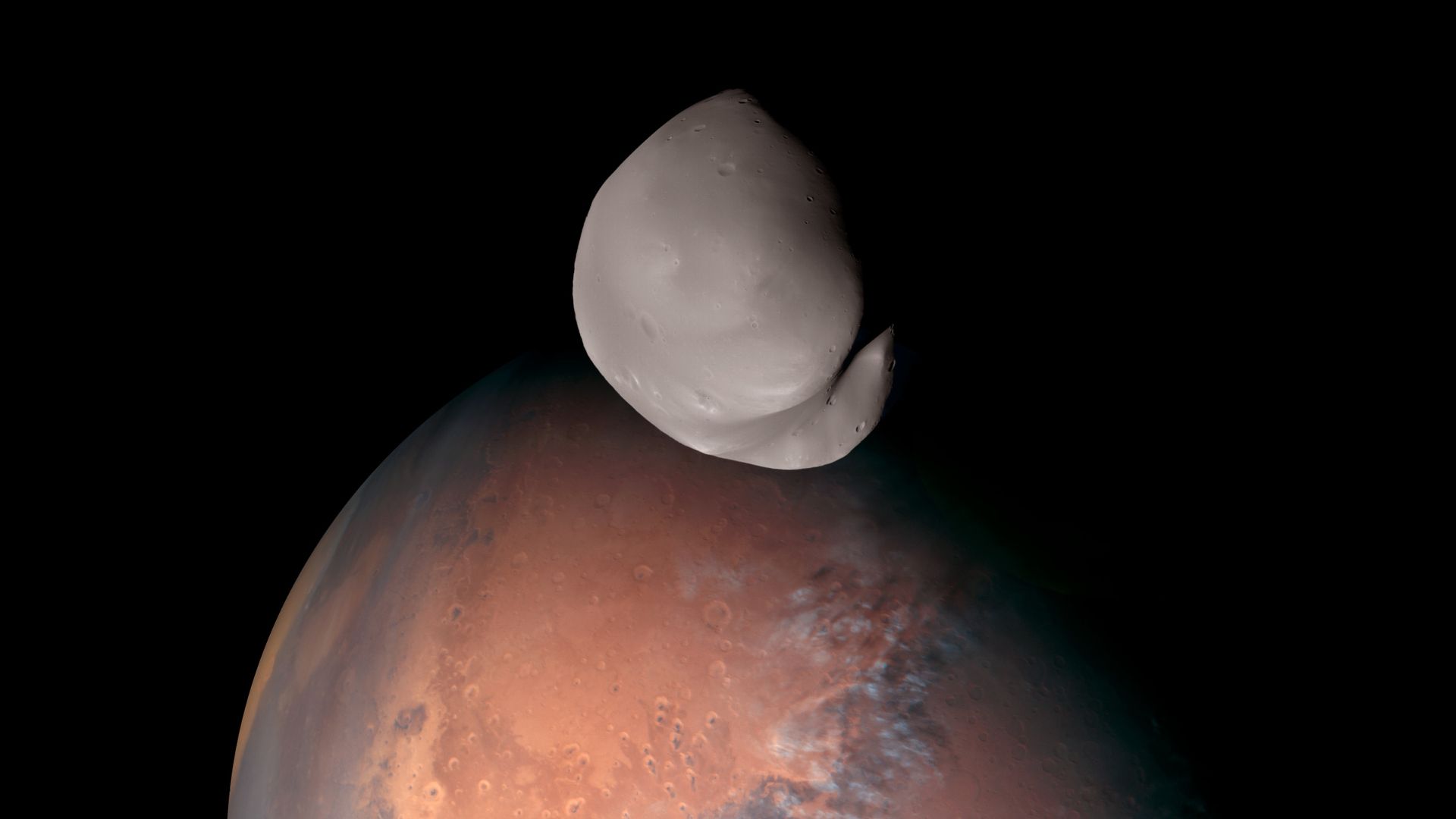
The Emirates Mars Mission (EMM), the first interplanetary exploration undertaken by an Arab nation, has unveiled a series of groundbreaking observations of Mars’ smaller moon, Deimos. The observations, shared during a special session at the European Geosciences Union General Assembly (EGU23) in Vienna, used all three of the mission’s science instruments (EMUS, EMIRS, and EXI) to reveal new details of Mars’ most mysterious moon and where it came from, as well as the Red Planet’s larger moon, Phobos.
The results provide new insights into Deimos’ composition and structure, as well as challenge the longstanding theory that Mars’ moons are captured asteroids, pointing instead to a planetary origin. The observations and images also reveal, for the first time, regions on the far side of Deimos whose composition has not been previously investigated.
“We are unsure of the origins of both Phobos and Deimos,” said Hessa AlMatroushi, EMM Science Lead and Senior Manager of the Earth and Planetary Science Section at Mohammed Bin Rashid Space Centre (MBRSC), United Arab Emirates. “One long-standing theory is that they are captured asteroids, but there are unresolved questions about their composition. How exactly they came to be in their current orbits is also an active area of study, and so any new information we can gain on the two moons, especially the more rarely observed Deimos, has the potential to unlock new understanding of Mars’ satellites.”
Evidence of a planetary origin
The new measurements include those from EMUS, a spectrometer that measures extreme and far ultraviolet wavelengths. The spectrum of reflected sunlight measured from Deimos was found to be flat and featureless, with no strong signatures of carbon minerals or organic materials, according to Justin Deighan, EMM Deputy Science Lead and a research scientist at the Laboratory for Atmospheric and Space Physics (LASP) at the University of Colorado Boulder.
“These findings suggest that Deimos may not be a D-type asteroid, the kind we’d expect if Mars’ gravity had captured an asteroid into orbit,” said Deighan, who is the science lead for the instrument. “Thanks to the orbiter, named ‘Hope’ (Al Amal in Arabic), we expect to build a better understanding of the origins and evolution of both Phobos and Deimos and to advance our fundamental understanding of these two moons of Mars.”
Christopher Edwards, the EMIRS instrument scientist and an associate professor in the Department of Astronomy and Planetary Science at Northern Arizona University, also presented results from the EMIRS instrument, which measures wavelengths in the thermal infrared. The preliminary analyses suggest that the surface of Deimos is rough at small scales and blanketed in fine regolith material, similar to Phobos and Earth’s Moon.
The data corroborate the interpretation that both of Mars’ moons are composed of dark, volcanic rock consistent with the Red Planet’s composition. “The findings to date suggest that both of Mars’ satellites may have formed from debris left over from an impact on Mars,” says Edwards. “These early findings are exciting and have big implications for understanding the formation of moons in our solar system. Differentiating between the captured asteroid and coalesced Mars debris hypotheses is something to which EMM is well positioned to make significant contributions.”
Images from EMM’s third instrument, EXI, which measures visible and ultraviolet wavelengths, revealed an unexpectedly smooth surface on the far side of Deimos. This is the closest flyby since Viking 2, providing an exciting opportunity to further investigate this little-studied moon, which is barely 12 kilometers (7.5 miles) across.
The scientists presented new, high-resolution images taken during flybys that passed within about 100 kilometers (60 miles) of the moon. EMM also made the first-ever observations in the extreme and far ultraviolet range of the spectrum, and the first well-resolved hyperspectral data of Deimos in the thermal infrared range. It is expected that additional observations during EMM’s Deimos campaign will further clarify the moon’s origin.
A unique knowledge partnership
EMM is part of a long-term, integrated effort to create economic opportunity through leadership in space science, research, and exploration. EMM is the culmination of a unique knowledge transfer and technical development effort started in 2006, which has seen Emirati engineers working with partners around the world to develop spacecraft design, engineering, and manufacturing capabilities, as well as building a dynamic science community around that effort.
EMM was developed by joint teams from MBRSC and LASP using facilities based at the University of Colorado Boulder, where more than 150 engineers and scientists have been involved in the mission’s development and scientific discoveries. LASP, Arizona State University/Northern Arizona University, and the Space Sciences Lab at the University of California, Berkeley contributed instruments to this partnership.
Coinciding with the release of the new imagery, the UAE Space Agency, which funds and operates EMM, also announced the mission will be extended into 2024. “The remarkable performance of the Mars Hope probe has supported a whole range of new observations in addition to meeting our originally stated science mission goals,” said UAE Space Agency Chair Sarah Al Amiri. “In the circumstances, Hope exceeding all expectations, we are extending the Emirates Mars Mission for a further year.”
-Written by Terri Cook, LASP’s Head of Communications
Founded a decade before NASA, the Laboratory for Atmospheric and Space Physics at the University of Colorado Boulder is on a mission to transform human understanding of the cosmos by pioneering new technologies and approaches to space science. LASP is the only academic research institute in the world to have sent instruments to every planet in our solar system. LASP began celebrating its 75th anniversary in April 2023.



